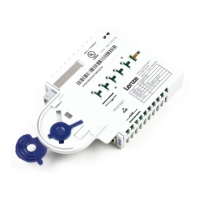Lenze · E94AYCER communication module (PROFINET®) · Communication Manual · DMS 11.0 EN · 04/2016 · TD17 17
4Technical data
4.4 Internal switch latency
_ _ _ _ _ _ _ _ _ _ _ _ _ _ _ _ _ _ _ _ _ _ _ _ _ _ _ _ _ _ _ _ _ _ _ _ _ _ _ _ _ _ _ _ _ _ _ _ _ _ _ _ _ _ _ _ _ _ _ _ _ _ _ _
4.4 Internal switch latency
The integrated 2-port switch causes runtime delays. These runtime delays can be calculated as
follows for modules up to and including SW version V01.40:
Example
20 process data words + 4 PROFIsafe words => 48 bytes
• ((36 permanent bytes + 48 bytes) x 8 x 10 nsec) + 4 μsec
• (84 bytes x 8 x 10 nsec) + 4 μsec
• 6.72 μsec + 4 μsec = 10.72 μsec
In accordance with the PROFINET specification, the shortest PROFINET I/O frame must have a data
length of 72 bytes. If the 36 permanent bytes are subtracted from the 72 bytes, 36 bytes are
available for process data. If now less than 36 bytes of process data are used, the PROFINET I/O
frame is filled with "zero bytes" until it can be transmitted. As a consequence for the calculation
formula, the shortest PROFINET I/O frame with 18 process data words (36 bytes) has always the
same length and thus the runtime delay is the same, too.
From SW version V2.10, a frame length-independent delay time of < 6 μs applies.
Runtime delay = ((36 permanent bytes + process data in bytes) x 8 x 10 nsec) + 4 μsec
Note!
The use of external switches can also lead to runtime delays. Depending on the system
constellation, it may be useful to create a star topology or a line/mix topology.
Network topology
( 25)

